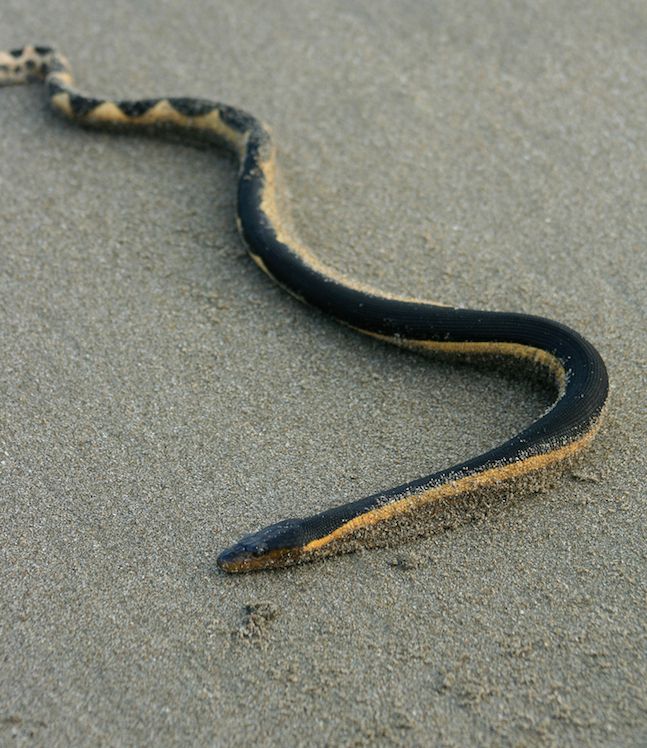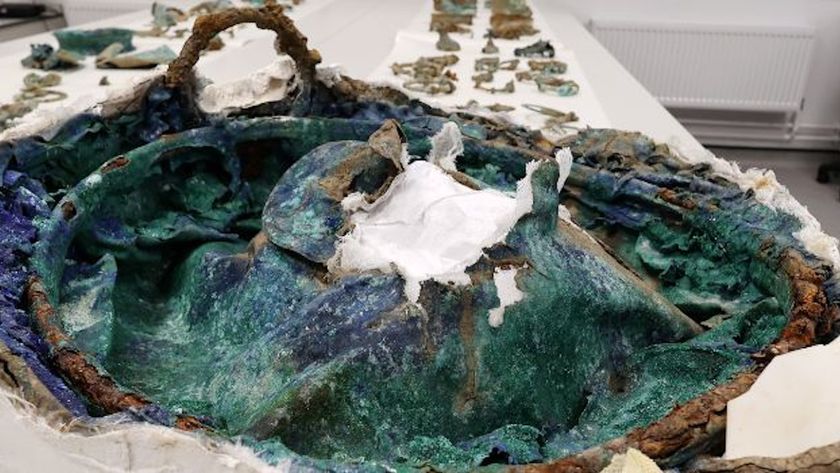Venomous Sea Snake Washes Up on California Beach, Surprising Scientists

A venomous sea snake washed up on a Southern California beach recently, striking fear in the hearts of beachgoers but eliciting excitement from the scientists who study these marine reptiles.
The stranded snake, which was dead when it was discovered on Dec. 12, was a yellow-bellied sea snake (Pelamis platura), the most widespread marine snake in the world. But despite its wide range of habitats, this snake isn't usually observed in the waters off the coast of Southern California, as it tends to keep to the warmer waters just south of that coastline, closer to Baja California, Mexico. Yet, in 2015, two of these critters washed up on California beaches, leading many to wonder why the snake is venturing outside its normal habitat.
"North of the tip of Baja [California], we have only five documented observations of this snake ever. Prior to this year, we only had three," said Greg Pauly, assistant curator of herpetology at the Natural History Museum of Los Angeles. The last time someone saw a yellow-bellied sea snake in California was in 1972, when one of these snakes washed ashore in San Clemente, he told Live Science. [7 Shocking Snake Stories]
So what is bringing the yellow-bellied sea snake to the shores of California? Pauly said the snake has only been observed in the region during El Niño years, or years in which sea-surface temperatures in the equatorial Pacific Ocean (which includes the waters just south of Southern California) are unusually high. What might be happening is that, as sea-surface temperatures rise and cause ocean currents to change as a result, the yellow-bellied sea snake moves a bit farther north, outside its usual haunting grounds, Pauly said.
However, as ocean temperatures off the coast of the western U.S. begin to cool during the winter months, the snakes may get sick or find themselves without enough food to survive, he said.
"As their health starts to decline, they get washed up onto these beaches — either because they're in poor health or because they already died and then get washed up after they're dead," Pauly said.
Folks who fear the venomous bite of the yellow-bellied sea snake may not lament that these snakes aren't alive when they hit dry land, but the truth is that P. platura doesn't pose much of a risk to humans, provided the humans who encounter them don't try to touch the snakes, Pauly said. While yellow-bellied sea snakes deliver a neurotoxin-packed bite, their venom is designed to take down small fish, not relatively large humans. (Their fangs and mouth size are also not built for biting large prey.) There have been no known human fatalities from envenomation by one of these snakes, Pauly noted.
Sign up for the Live Science daily newsletter now
Get the world’s most fascinating discoveries delivered straight to your inbox.
Pauly called the snake's appearance in Southern California "exciting" because these animals are so rarely observed in the U.S. The appearance of two such snakes in one year is "unprecedented" (and also "pretty amazing"), he said.
Yellow-bellied sea snakes aren't the only marine creatures to come ashore since the onset of El Niño in 2015. In June, sea slugs, or sea hares — which look a lot like big, purple blobs — started appearing on the beaches along Oakland's East Bay in California. That same month, thousands of tiny red crabs, or tuna crabs (Pleuroncodes planipes), washed up on beaches in Orange and San Diego counties in California. But all of these critters, which typically inhabit warmer waters farther south, are likely showing up on beaches in the U.S. for the same reasons, Pauly said.
"There are a couple of things going on, most likely: We're seeing this really strong El Niño, and because of these warmer sea-surface temperatures, a lot of species are showing this response [of coming north], Pauly said. "El Niño is certainly one culprit. But there are a couple of other things going on with the sea-surface temperatures right now."
Specifically, there's something called the Pacific Decadal Oscillation (PDO), which means that the Eastern Pacific (including the water off Southern California) is getting warmer. And then there's the "blob."
"The blob is actually three different blobs — some really unusual areas where really big chunks of the ocean off the coast of North America are much warmer than usual," Pauly said. "And normally, what happens is that sea-surface temperatures cool during the winter months, but there are these three areas where the temperatures are staying warmer than normal by several degrees."
One of those blobs just happens to sit right off the coast of Southern California. Together with El Niño and the PDO, the blobs may be increasing sea-surface temperatures enough to encourage warm-water species — the yellow-bellied snake and its friends — to venture farther north than they normally would.
So what should you do if you see an unusual sea creature washed up on your local beach? That's simple, Pauly said: Take a picture. Then, send that picture to the Natural History Museum of Los Angeles (nature@nhm.org). Scientists there will be glad to see what you've stumbled upon. Just do yourself a favor and look, don't touch.
Follow Elizabeth Palermo @techEpalermo. Follow Live Science @livescience, Facebook & Google+. Original article on Live Science.

Elizabeth is a former Live Science associate editor and current director of audience development at the Chamber of Commerce. She graduated with a bachelor of arts degree from George Washington University. Elizabeth has traveled throughout the Americas, studying political systems and indigenous cultures and teaching English to students of all ages.












